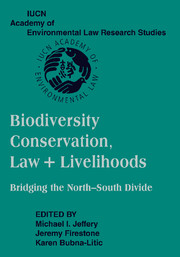 Biodiversity Conservation, Law and Livelihoods: Bridging the North-South Divide
Biodiversity Conservation, Law and Livelihoods: Bridging the North-South Divide Published online by Cambridge University Press: 31 July 2009
INTRODUCTION
The enforceability and hence effectiveness of environmental law depends to some extent on the language used to express its rules. Apart from environment itself, such words include protection, conservation, enhancement, improvement, utilisation, precaution, sustainability, equity, heritage, nature, and, of course, biological diversity (hereafter biodiversity). Words such as these perform different functions. Some are descriptive; a few state objectives; a number describe processes and procedures; some state values. Perhaps the function of some is unclear. Often, however, the way in which words are used, their relationship with other words and the context of their use illuminate their meaning and the part they play in the system that comprises the rules of environmental law. So it is with the conservation of biodiversity.
The conservation of biodiversity – which is part of the natural and cultural environment – together with the protection of the environment from harm are merely two of the essential elements of the concept of sustainability. Although sustainable development drives much of contemporary environmental law, it is by no means certain what are its functions and its status within the legal system. As we shall see, sustainable development is in some respects an outcome to be achieved by the detailed methodology of decision making prescribed by the legal system. How this is incorporated within the legal system is an ongoing challenge. Despite a significant number of responses to this challenge, there is no clear or consistent doctrinal approach from the perspective of the law.
To save this book to your Kindle, first ensure [email protected] is added to your Approved Personal Document E-mail List under your Personal Document Settings on the Manage Your Content and Devices page of your Amazon account. Then enter the ‘name’ part of your Kindle email address below. Find out more about saving to your Kindle.
Note you can select to save to either the @free.kindle.com or @kindle.com variations. ‘@free.kindle.com’ emails are free but can only be saved to your device when it is connected to wi-fi. ‘@kindle.com’ emails can be delivered even when you are not connected to wi-fi, but note that service fees apply.
Find out more about the Kindle Personal Document Service.
To save content items to your account, please confirm that you agree to abide by our usage policies. If this is the first time you use this feature, you will be asked to authorise Cambridge Core to connect with your account. Find out more about saving content to Dropbox.
To save content items to your account, please confirm that you agree to abide by our usage policies. If this is the first time you use this feature, you will be asked to authorise Cambridge Core to connect with your account. Find out more about saving content to Google Drive.